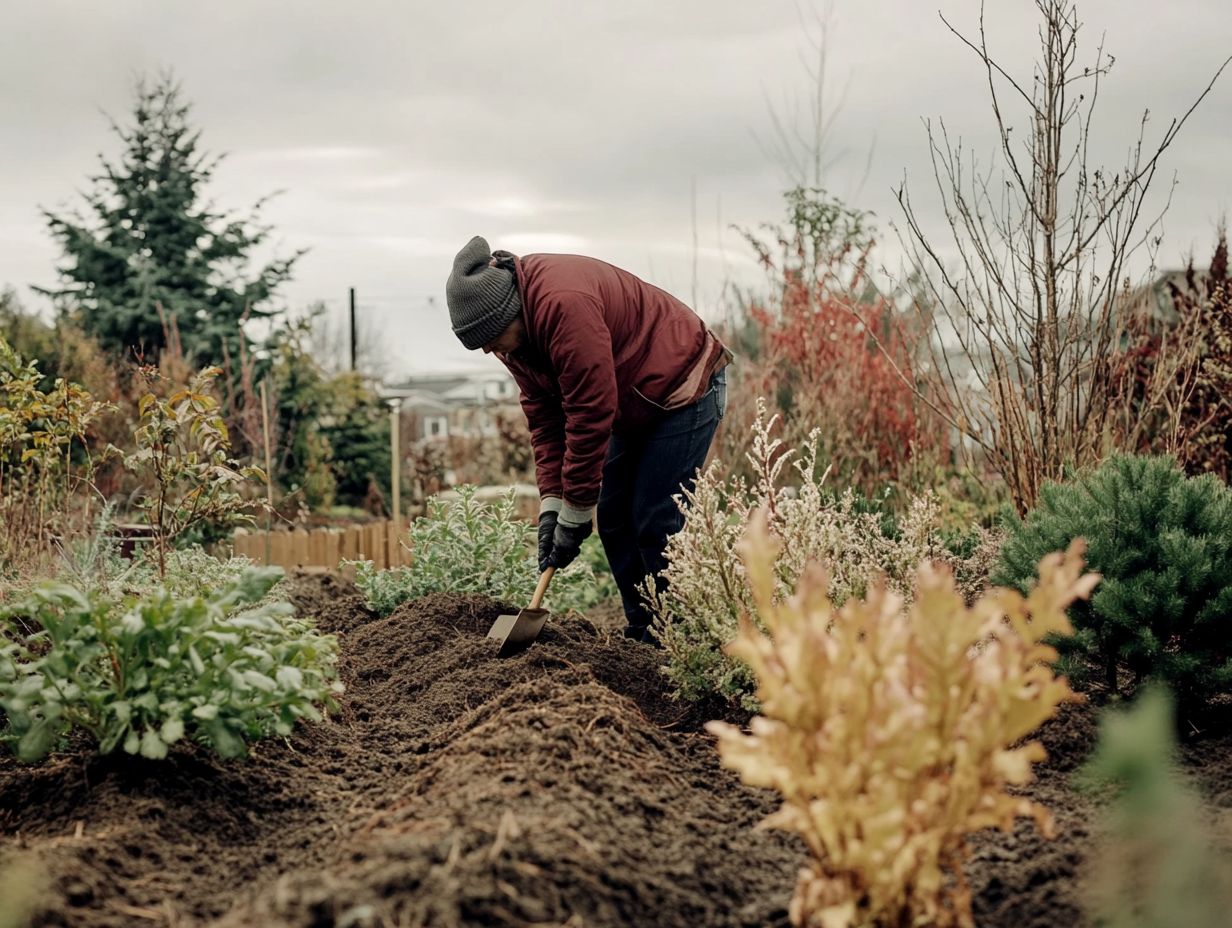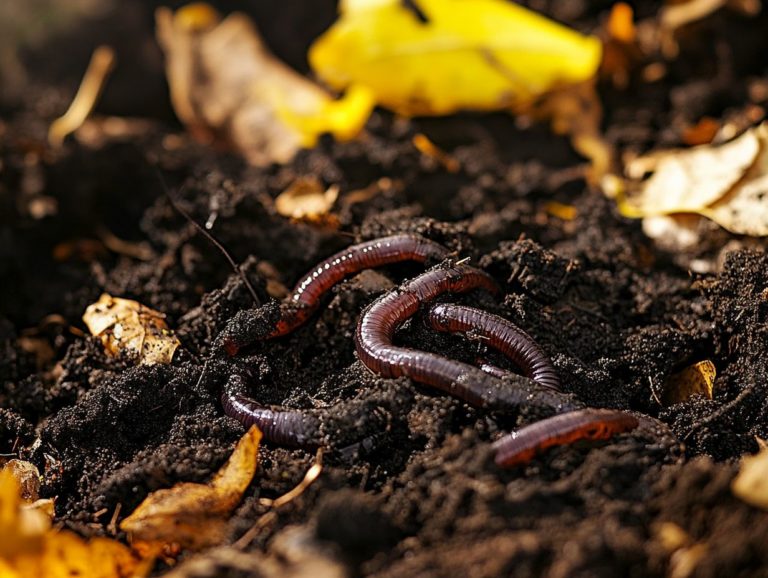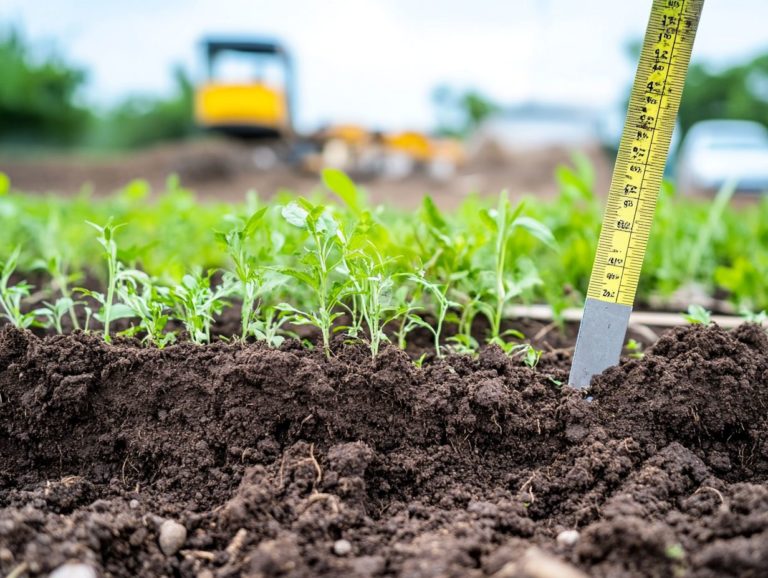Preparing Soil for Cold-Weather Perennials
Cold-weather perennials are your secret weapon as a gardener. They provide vibrant blooms and lush foliage even when temperatures drop, making them ideal for autumn gardening and winterizing perennials.
By understanding their unique benefits, you can transform your garden into a year-round spectacle. This guide will assist you in selecting the right plants, preparing the soil, and mastering planting techniques for optimal growth. You ll find essential gardening tips for a healthy garden.
This guide will also cover essential care tips, highlight common pitfalls to avoid, and offer strategies to protect your plants from harsh winter conditions. You’ll learn how to insulate plants and remove weeds effectively.
Jump in now to create your own vibrant cold-weather garden! Get ready to plant bulbs and create a perennial garden that flourishes.
Contents
- Key Takeaways:
- Benefits of Growing Cold-Weather Perennials
- Preparation for Planting
- Planting Cold-Weather Perennials
- Care and Maintenance for Cold-Weather Perennials
- Common Mistakes to Avoid
- Frequently Asked Questions
- What are cold-weather perennials and why do I need to prepare my soil for them?
- When is the best time to prepare my soil for cold-weather perennials?
- What are the key elements to consider when preparing soil for cold-weather perennials?
- How can I improve the drainage in my soil for cold-weather perennials?
- What steps should I take to adjust the pH levels in my soil for cold-weather perennials?
- Are there any specific nutrients that cold-weather perennials need in their soil?
Key Takeaways:

- Cold-weather perennials are plants that can withstand freezing temperatures and continue to bloom year after year.
- Preparing soil for cold-weather perennials involves assessing soil quality and amending it with organic matter for optimal growth.
- Proper planting techniques, regular watering and fertilizing, and protecting plants from extreme cold are essential for successful growth, including the best ways to water perennials and mulch.
What are Cold-Weather Perennials?
Cold-weather perennials are hardy plants that thrive in zones that indicate plant hardiness based on climate. They deliver vibrant blooms even when frost is biting. Examples include geraniums, roses, and camellias, which are perfect for community gardening.
It s essential to understand the characteristics of these plants, including their soil and water needs, to achieve success in urban and sustainable gardening.
Among your options, arborvitae stands out as a classic choice for winterizing perennials. It provides a lush backdrop of greenery throughout the cold seasons. Alternatively, star jasmine adds a fragrant touch and adapts beautifully to various conditions, whether nestled in shaded corners or basking in brighter, sunnier spots.
The secret to caring for perennials lies in knowing how to nurture these varieties according to their unique needs. Ensuring they thrive across different climates, especially in challenging environments like Florida gardening, is crucial. Investing a little time in maintenance will greatly reward you with stunning blooms!
Benefits of Growing Cold-Weather Perennials
Growing cold-weather perennials offers a wealth of advantages for you as a gardener, especially in urban gardening settings. These plants enhance biodiversity, foster a thriving garden ecosystem, and provide seasonal beauty that lingers well into the colder months. This makes them a favorite for sustainable gardening practices.
Their resilience makes them ideal for urban gardening, and they align beautifully with sustainable practices, requiring less maintenance and water than annuals. By choosing perennials, you re not just cultivating a garden; you re creating a vibrant, eco-friendly space that stands the test of time, perfect for container gardening as well.
Advantages for Gardeners
The advantages of growing cold-weather perennials are numerous. They allow you to create vibrant landscapes that require minimal effort while delivering lasting color and texture, especially during spring blooms. These plants are particularly beneficial for urban gardening enthusiasts and anyone looking to simplify their gardening efforts. They are designed to withstand harsh freezes and thrive in various soil conditions.
A major benefit is their low maintenance requirements, making them perfect for busy individuals. Instead of worrying about constant watering, these resilient perennials can store moisture efficiently, reducing your garden upkeep.
When combined with mulch perennials, the soil retains moisture even better, promoting healthier growth. The seasonal interest these hardy plants provide think striking plants like Cacti and Junipers ensures your garden remains visually appealing throughout the year.
This creates an enriching experience for both novice and seasoned gardeners, deepening your connection with nature, especially when engaging in community gardening.
Preparation for Planting
Preparing for planting cold-weather perennials is essential for their healthy growth and resilience. A key step is preparing your planting beds for winter, starting with a detailed soil test to assess pH levels, nutrient content, and moisture retention capabilities.
By understanding the specific needs of each perennial, you can amend your soil precisely. Incorporate compost, fertilizers, and mulch perennials to create a nutrient-rich environment that fosters enduring vitality and robust development.
Assessing Soil Quality

Assessing soil quality is vital. It involves evaluating texture, pH, and nutrient levels key factors in fostering the successful growth of cold-weather perennials. Regular soil testing not only informs you of your garden’s needs but also offers insights into enriching your soil through composting and fertilization.
Understanding how different soil types like sandy, loamy, and clay soils manage water is crucial. For example, loamy soils, rich in organic matter, support vigorous plant growth due to their balanced nutrient composition, essential for healthy perennials. By adding beneficial amendments like well-rotted manure or biochar, you can boost your soil’s health and watch your perennials thrive.
Monitoring soil organic matter levels helps you appreciate how different textures affect nutrient availability. Generally, higher organic matter improves moisture retention and nutrient supply both vital for a flourishing perennial garden.
Amending Soil for Optimal Growth
Amending your soil for the optimal growth of cold-weather perennials means adjusting its composition to enhance drainage, aeration, and nutrient availability. This creates a balanced ecosystem where your plants can thrive. One important step is preparing soil for early spring planting, which involves adding compost and organic matter crucial for improving soil structure, especially for tender perennials that crave rich, moist soil.
Using fertilizers can significantly enhance your soil’s nutrient profile, providing essential elements like nitrogen, phosphorus, and potassium crucial for maintaining vibrant plant health.
Seasonal care should also include techniques for retaining moisture levels, such as mulching. This helps keep water in and acts as a barrier against pesky weeds.
Implementing a regular watering schedule tailored to changing weather patterns ensures your soil stays adequately moist. This fosters robust root development and alleviates stress on your plants while nurturing tender perennials.
Follow these best practices now, and watch your garden become vibrant and sustainable!
Planting Cold-Weather Perennials
The optimal time to plant cold-weather perennials is in early autumn. This is a perfect time for Florida gardening enthusiasts to prepare their gardens. It allows plants to develop a strong root system before the winter chill sets in.
Using proper planting techniques, such as digging holes of the right size and maintaining sufficient spacing between plants, is crucial for healthy growth. These practices will ensure your perennial garden bursts into bloom come spring.
Best Time to Plant
The best time to plant cold-weather perennials is typically early autumn, coinciding with preparations for planting bulbs. This timing allows your plants to establish their roots before winter arrives, setting the stage for vibrant blooms in spring. It’s an important time for anyone wanting to grow a lush and flourishing perennial garden, and utilizing the top 10 soil amendments for cold-weather gardens can help you take full advantage of the moist soil conditions often found during this season.
The ideal planting window can vary by region. For example, if you live in a warmer area, late summer might be perfect, while those in colder regions could benefit from planting just before the first frost. Monitor local weather patterns, especially when the average temperature dips below 50 F. This can indicate when to start planting and caring for your garden.
Incorporating mulching protects your newly planted perennials from winter freezes, ensuring they thrive when spring rolls around. By aligning your planting schedule with these variables, you can enhance your perennial outcomes.
Proper Planting Techniques
Proper planting techniques are vital for establishing cold-weather perennials. This involves thoughtful steps such as digging holes that accommodate root depth and spacing plants for optimal air circulation. Additionally, understanding soil needs for cold-climate plants nurtures healthy growth for your tender perennials and contributes to the overall vitality of your garden.
To start, ensure the holes are wide enough to allow the roots to spread comfortably ideally, they should be twice the width of the root ball. Maintain proper spacing; aim for about 12 to 24 inches between plants, depending on their mature size.
After planting, water deeply using a soaker hose or a drip irrigation system (which delivers water directly to the plant roots, saving water and ensuring healthy growth) to ensure consistent moisture. Mulching around the base of each plant will help retain moisture while keeping pesky weeds at bay.
By following these guidelines, you’ll create a flourishing environment where cold-weather perennials can thrive, enhancing the beauty and functionality of your garden layout. For detailed advice, check out preparing your garden for winter.
Care and Maintenance for Cold-Weather Perennials

Caring for your cold-weather perennials can be exciting and rewarding! This requires a thoughtful approach to watering, fertilizing, and shielding your plants from harsh winter conditions. For the best results, consider using the top 10 perennials for cold-weather gardens, ensuring they flourish during the colder months.
By establishing a routine that incorporates regular soil assessments and moisture monitoring, you not only sustain the health of your plants but also set the stage for a stunning garden display come springtime.
Get started on your perennial garden today! The beautiful blooms of spring are just around the corner!
Watering and Fertilizing
Watering and fertilizing are essential for maintaining healthy cold-weather perennials. The key is to keep the soil consistently moist without causing waterlogging. Applying fertilizers during the growing season not only enhances plant health but also boosts the establishment and blooming potential of these resilient beauties.
To achieve this balance, consider methods like drip irrigation or soaker hoses. These methods allow for slow, deep watering, which your plants will appreciate. Using organic fertilizers, such as compost or well-rotted manure, enriches soil structure and nutrient content, creating the perfect environment for various perennial species.
Tailoring your fertilization schedule to meet specific plant needs is crucial. For example, spring-blooming varieties thrive with an early dose of fertilizer, while summer bloomers benefit from a mid-season boost. By paying attention to seasonal changes, you ensure your plants receive the nourishment they need to flourish throughout the winter months.
Protecting Plants from Cold Weather
Protecting your plants from cold weather is vital for the survival of cold-weather perennials. Employ strategies like mulching and insulating them against harsh elements. Cover tender perennials with frost cloth or apply organic mulches to significantly boost their ability to endure freezing temperatures.
You can also use row covers and cloches to create a mini-greenhouse effect, providing an extra layer of warmth. Place windbreaks like burlap screens or evergreen shrubs to effectively reduce wind chill. Think carefully about where to place your plants to maximize their sunlight exposure, as this will help warm them during the day.
By implementing various protection methods, you significantly increase your chances of preserving your plants throughout winter, promoting healthier growth and resilience in the long run.
Common Mistakes to Avoid
When growing cold-weather perennials, it s essential to avoid common mistakes that can impact their health and blooming potential. Issues often arise from improper watering, neglecting soil quality, or not adequately protecting your plants during chilly spells.
By recognizing these pitfalls, you can adopt smarter strategies for a healthier and more vibrant garden environment.
Tips for Successful Growth
To ensure the successful growth of cold-weather perennials, adopt best practices like regular soil testing, establishing appropriate watering schedules, and timely fertilization. Additionally, preparing soil for fall planting can enhance your gardening results. Engaging with community gardening initiatives can provide invaluable insights and support from fellow gardening enthusiasts.
Consider mulching to safeguard your plant roots from extreme temperatures, enhance moisture retention, and reduce weed competition. Implementing companion planting can further optimize growth, creating a balanced ecosystem where your plants thrive together.
As the seasons shift, stay informed about local weather patterns to make timely adjustments to your watering and feeding schedules. Building relationships with local gardening clubs and participating in workshops can offer fresh ideas and resources, ensuring you are well-equipped to navigate the unique challenges of cold-weather climates.
Start implementing these tips today and watch your garden flourish!
Frequently Asked Questions

What are cold-weather perennials and why do I need to prepare my soil for them?
Cold-weather perennials are plants that can survive and thrive in colder climates. To enhance their growth, preparing your cold-climate garden for rain and ensuring specific soil conditions will be crucial for their success in your garden.
When is the best time to prepare my soil for cold-weather perennials?
The best time to prepare your soil for cold-weather perennials is in the fall, a few weeks before the first frost. This timing allows the soil to settle and lets nutrients reach the plant’s roots before the cold weather sets in, especially with soil preparation for container gardening in cold climates.
What are the key elements to consider when preparing soil for cold-weather perennials?
When preparing soil for cold-weather perennials, consider drainage, pH levels, and nutrient content. For more detailed guidance, check out our tips on preparing your soil for spring in cold climates. These factors are crucial to your plants’ growth and health.
How can I improve the drainage in my soil for cold-weather perennials?
You can also add organic matter like compost or peat moss. This will loosen compacted soil and help water drain properly.
What steps should I take to adjust the pH levels in my soil for cold-weather perennials?
To adjust the pH, which is the soil’s acidity or alkalinity, add amendments like lime or sulfur. Be sure to test your soil beforehand to determine how much to add and retest after making changes.
Are there any specific nutrients that cold-weather perennials need in their soil?
To thrive, cold-weather perennials need the right balance of nutrients, including nitrogen, phosphorus, and potassium. You can provide these by adding a slow-release fertilizer or organic matter.






